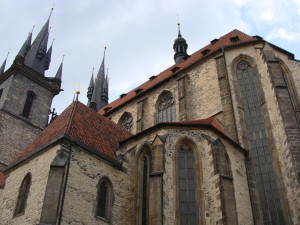
The Jerusalem Post, September 11, 2009
Viewed from Old Town’s cobblestone streets, Prague is Europe rendered as a confectionary wonder. Pastel-hued buildings, with baroque curves and curlicues that resemble icing, lick at the spire-filled sky. Even the sharp lines of Gothic structures seem the stuff of children’s birthday cakes—reminding the viewer less of history and more of fairytales with pink-frocked princesses locked in dark towers.
To scrape away the marzipan (and the tourist crowds) cross Vltava River and head on high to Letna Park (Letenske sady), a sprawling neighborhood park that’s rarely mentioned in guidebooks. Here you’ll get breathtaking views of the city, glimpses of the locals, a summer beer garden, and a dash of Communist history to boot.
Maybe it’s better to say that the boots, or sneakers, are stomping on Communist history—climb the long set of stairs to Letna Park and the first thing you’ll see is skateboarders. Gliding over granite, their wheels fly where an imposing statue of Stalin once cast a long shadow.
Erected on the hilltop in 1955, the 14,000 ton, 50-foot monument depicted Stalin leading a line of workers towards the horizon. One of the world’s largest statues of Stalin, it loomed over the city for seven years until the Czechs destroyed it in 1962, long after Stalin had been denounced by his successor. Stalin’s spot was held empty until 1991 when a large metronome—a long, red pole that looks more appropriate for catching fish than keeping time—took its place. Still, locals continue to call this area of the park Stalin Square.
Beyond the slabs of grey, shaded walkways and picnic-perfect grasses await. On a warm day, a few impromptu sunbathers lounge in their undergarments. A line of long white-backed men lie near a pair of women who have shed their tops and sit, their faces turned towards the sky, wearing only black bras and jeans.
Partial nudity is by no means mandatory. Indeed, a vast majority of the park’s visitors—families, couples young and old, clumps of friends, and strings of rollerbladers—keep their clothes on.
The elegant Hanavsky Pavilion might even inspire some to dress up a bit. The cream-coated building, topped with a gilded-onion-dome, hints of a nobleman’s retreat in the hills. Rather, the neo-Renaissance pavilion was built in the late 1800s for the World Fair. Today it’s a restaurant serving pricey continental dishes alongside an equally rich vista of Prague. But opt for a drink and you can sip in the view for less.
Either way, make sure to grab front seats on Hanavsky Pavilion’s wrought-iron-edged veranda. Below you, on the other side of the thick, lazy Vlatva—a river that seems to lumber along—is Prague’s Old Town (Stare Mesto), dominated by the black steeples of Tyn Church. Construction began on this Gothic giant in the 1300s and took nearly a century to complete. Its spike-like spires are a landmark of Old Town Square.
Across from Tyn Church, anchoring the other side of the plaza is St. Nicholas Church. From your bird’s-nest view, you can pick out St. Nicholas Church by its gently sloping green caps, peeking over the surrounding red roofs. With its puffy cupcake domes, leftovers from the Baroque period, St. Nicholas Church couldn’t be more different that its imposing neighbor. But Old Town Square’s architectural jumble is quintessential Prague.
Although you may not be able to make out particular buildings, from Hanavsky’s Pavilion you can catch a glimpse of Prague’s Jewish Quarter, home to the oddly named Old-New Synagogue. Built in the late 13th century, the Old-New Synagogue is the oldest remaining shul in Europe. Its stone interior is small and simple; its façade is notable for its steeply angled roof.
The adjacent Old Jewish Cemetery—which you’ll have to wait to see until you’re back on the ground—whispers of the Golem. Amongst the heaps of headstones, lies the resting place of Rabbi Judah Loew Ben Bezalel. According to legend, Rabbi Loew gave life to the giant clay creature in order to protect the inhabitants of the Jewish Quarter from anti-Semitic attacks. Though September marks the 400th anniversary of Rabbi Loew’s death, his Golem remains an emblem of Prague.
From Hanavsky Pavilion, you can also see Prague’s many bridges. They stand one after another as though they are waiting in line, smiling and patient. Following the river, their silhouettes extend to the horizon—giving the sense that Prague goes on forever.
Famed Charles Bridge (Karluv most) is among them. Once you’ve descended from this hillside retreat, a stroll there is a must. Linking Old Town to Prague Castle, the bridge is edged with bronze statues of saints, some of whose patinas have been rubbed away by visiting pilgrims. You’ll see throngs of tourists in queue to pray at the feet of one saint or another.
After you’ve finished drinking in the view and mapping out your Prague itinerary from above, head over to Letna Park’s Beer Garden to fortify yourself for the crowds below. In the summer, this quiet canopy of trees turns into a buzzing outdoor beer hall, complete with chain-smoking locals. Friends and strangers alike squeeze onto plank bench perches. Plastic cups (sorry, no hefty glass mugs here) crowd together on the long, wooden tables. And of course there’s beer, which is just as much a part of Czech history as, say, communism, kings, or the Golem.
At the Beer Garden, you’ll also find what seems to be another Czech staple—sausage, slathered in mustard, wedged into thick-crusted white bread. A bit heavy for summer, perhaps, but perfect if your afternoon plans call for a nap in the shade.
Like Stalin Square and Hanavsky Pavilion, the Beer Garden also boasts a spectacular view of Prague. Take one last look as a farewell to Letna Park, the ticking metronome, and partially clad sunbathers. With an amiable buzz, you’re ready now to take on the crowds of tourists, shuffling their way through the city in a sugary haze.